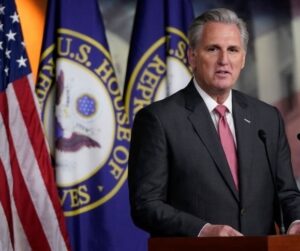Despite the doom and gloom surrounding the debt ceiling, global financial markets have barely reacted to default warnings. Everyone has watched this show and the endless sequels and remakes before. The federal debt limit approaches, the Treasury employs extraordinary measures, both sides of the aisle jockey for position, and the Republican or Democratic leadership concedes and supports adding more to the national debt. This happened again on April 17 when House Speaker Kevin McCarthy (R-CA) emulated his predecessors and promised fiscal responsibility while raising the debt ceiling.
The Debt Ceiling
Speaking at the New York Stock Exchange, McCarthy revealed that Republicans would vote on legislation in the coming weeks to raise the debt ceiling for one year, roll back federal spending to 2022 levels, and implement new work requirements for Medicaid and food stamps. However, he confirmed that “a no-strings-attached debt limit increase will not pass” the lower chamber, adding that “since the president continues to hide, House Republicans will take action.”
McCarthy, who marked his 100th day as Speaker of the House, vowed that his plan would save taxpayers trillions of dollars, reduce US dependence on China, curb high inflation, and advance the nation toward fiscal responsibility. While a detailed official plan has yet to be proposed, McCarthy has proffered some ideas behind the bill:
- Limit the annual growth of spending over the next ten years to 1%.
- Examine wasteful federal government expenditures.
- Claw back tens of billions of dollars in COVID-related funds.
“This will restore discipline to Washington. This budget will help put an end to reckless spending causing inflation,” he said. “Before we borrow another dime, we owe it to our children to save money everywhere.”
But while he stopped short of verifying that he had his party’s full support – he has a five-seat margin to work with – McCarthy informed the audience that he does not give up and would never give up on the American people. “We will not rest until the economy is healthier, and our country is more confident. Until our children’s future is brighter,” McCarthy stated.

Kevin McCarthy (Photo by Win McNamee/Getty Images)
He will likely face exceptional pushback on any attempts to reform welfare spending, like food stamps, and be accused of hating the impecunious. But McCarthy attempted to get ahead of this narrative by noting that “assistance programs are supposed to be temporary, not permanent. A hand up, not a handout.” The House Speaker believes that the White House’s “out-of-whack” work requirements have incentivized Americans to not return to the labor force, as there are more job openings than individuals searching for employment opportunities.
In the end, President Joe Biden should be blamed if default fears arise in the financial markets because he has refrained from negotiating with the Republican Party. “The longer President Biden waits to be sensible to find an agreement, the more likely it becomes that this administration will bumble into the first default in our nation’s history,” McCarthy averred, adding that insolvency is not an option, “but neither is a future of higher taxes, higher interest rates, more dependency on China and an economy that doesn’t work for working Americans,
Liberty Nation recently reported that the US government is already on track for another trillion-dollar-plus shortfall. In the first half of the fiscal year 2023, the budget deficit surged to $1.101 trillion, thanks to a $378 billion increase in March. This was driven by a 13% jump in government spending, a 3% decline in revenues, and a 32% increase in interest payments ($301 billion). In addition, Biden’s 2024 budget proposes more than $17 trillion of cumulative deficits by 2033.
Back to 2022
McCarthy’s margin of error is thin. If the legislative pursuit is presented and he loses the Freedom Caucus, the political theater should be compelling and popcorn-inducing entertainment. The measures outlined by McCarthy would be sensible and responsible for any conservative. What is wrong with freezing spending to 2022 levels? The US government spent about $6.2 trillion. By comparison, the federal government is projected to spend $6.3 trillion in 2023 and $6.9 trillion in 2024. What are a few hundred billion dollars among friends?
 For anyone who has watched these debt ceiling tribulations and budget negotiations, one side will always accept defeat while convincing everyone else that they won the battle. For example, during the sequester saga under former President Barack Obama, the Republicans under Paul Ryan acted like they had achieved a victory for fiscal conservatism because they got a spending cap that lowered spending by 1.6%. At the time, opponents asserted that the cupboard was bare and that outlay declines would devastate US households. So far, the post-speech reaction has been the same.
For anyone who has watched these debt ceiling tribulations and budget negotiations, one side will always accept defeat while convincing everyone else that they won the battle. For example, during the sequester saga under former President Barack Obama, the Republicans under Paul Ryan acted like they had achieved a victory for fiscal conservatism because they got a spending cap that lowered spending by 1.6%. At the time, opponents asserted that the cupboard was bare and that outlay declines would devastate US households. So far, the post-speech reaction has been the same.
If McCarthy convinced Biden and the Democrats to return spending to 2022 levels, it would cut approximately 10% from the budget. If the left cannot handle a 1.6% reduction, how could Democrats cope with a double-digit decrease? Eventually, the elephants and donkeys will be forced to take the budget seriously, and lawmakers will need to take a multi-trillion-dollar chainsaw to the public ledger.
All opinions expressed are those of the author and do not necessarily represent those of Liberty Nation.
Do you have an opinion about this article? We’d love to hear it! If you send your comments to [email protected], we might even publish your edited remarks in our new feature, LN Readers Speak Out. Remember to include the title of the article along with your name, city, and state.
Please respect our republishing guidelines. Republication permission does not equal site endorsement. Click here.

